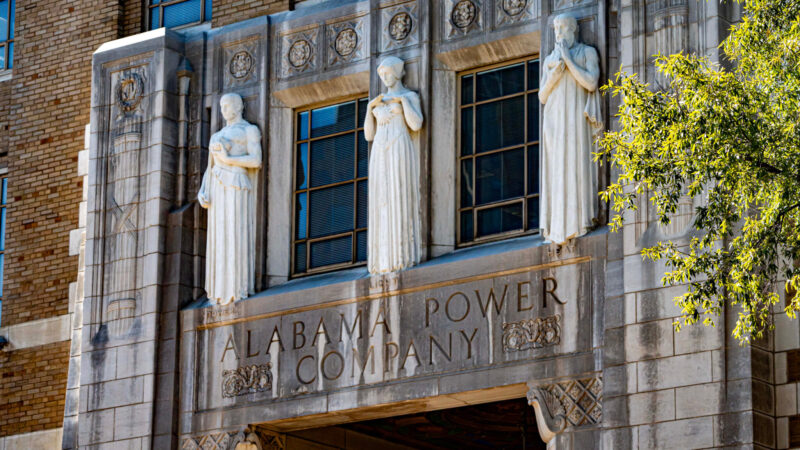Southern Environmentalism
When Forbes Magazine ranked states by their “greenness” the usual suspects topped the list – Vermont, Oregon, and Washington, all progressive states known for their environmental movements. Seven out of the ten “least green” states were in the South, the land of coal mines and timber plots. But as WBHM’s Tanya Ott reports there’s a growing environmental movement down south and some of its members might surprise you.
There’s a vacant lot in downtown Birmingham, Alabama. It’s full of overgrown weeds, surrounded by warehouses that don’t look like they’ve been used in years. There’s really not a lot going on here. But James Smith sees something entirely different. He’s president of an international company called Green Building Focus. When he looks at this lot, he sees an uptapped market. He wants to build an eco-industrial park here.
“There are many companies out there in other parts of the country who want to have access to the southeastern market, they realize it’s one of the fastest growing markets in the country. And if you draw a 500 mile radius around Birmingham you hit every major developing area in the southeast. It’s really the ideal location geographically to become a regional manufacturing hub for sustainable products.”
Alabama, a green hub of the south? This is the land of mega-churches and Republicans, not environmentalists.
“The federal trend over the last 10 years, longer than that, no doubt has been if you’re a Republican you can’t be an environmentalist.”
That’s Gil Rogers. He’s an attorney with the Southern Environmental Law Center. He says nationally republicans get a bad rap for denying climate change and trying to roll back the endangered species list. But at the state and local level, things are often different in the south.
“We have a lot of republican champions, as an example, in the Georgia legislature that are republicans in terms of wanting lower taxes and less government intrusion into a lot of aspects of life. But then will go and realize that there needs to be more done in the way of environmental protection of water resources or of air quality. That those have real public health impacts.”
Rogers says these leaders often have strong ties their own piece of nature – maybe a stretch of land or a river.
“I’m a tree hugging, liberal – I mean a tree hugging conservative republican!Which I know some people may say is an oxymoron. But…”
That’s Charlie Houser. He’s mayor of Magnolia Springs, Alabama. It’s a small town of about 8,000 residents down by Mobile. Magnolia Springs is just as lovely as its name. Huge live oaks canopy the main street. But the rest action is on the river.
Houser fires up his pontoon boat to give me a tour. Magnolia Springs is the only place in the U.S. with full-time mail delivery by boat.
“We have had flooding where you have to call somebody and say, I got your bill but I couldn’t read it cause it was wet!”
Houser grew up here. When he moved back to retire, he worried about what he saw.
“I didn’t see the sea grass. We lost blue crabs, we lost pike.”
He blames agricultural runoff full of chemicals. So, when the town incorporated four years ago one of the first things mayor Houser and the mostly republican town council did was pass some of the toughest land use rules in the south. All new buildings have to set back 75 feet from the river. New subdivisions have to keep their run-off on site. The town has spent more than a quarter million dollars on a comprehensive plan and creating an Environmental Protection Committee. And it’s working, says councileman Ken Underwood.
“We started having brown pelicans showing back up. And today all the pelicans you see around, that’s a wonderful site. That’s a sign that the river is in better shape on a chemical basis. Look at the cormorants up in the treetops there. Beautiful site!”
Beautiful, and profitable. Today, Magnolia Springs economic engine is tourism and the revitalized river plays a big role in that.
Gil Rogers, with the Southern Environmental Law Center, says there are still big environmental threats in the south: coal mining, timber, and other industries. But he’s optimistic.
“People have started to recognize that there’re some real threats from population growth, poor development patterns. So I think there is a movement here going on and it’s unique to the south, I think, in a lot of ways.”
Certainly, it’s creating some interesting alliances such as environmentalists teaming up with hunters. It’s a small sign that conservative and conservation are little closer than they once were in the South.
How Alabama Power kept bills up and opposition out to become one of the most powerful utilities in the country
In one of the poorest states in America, the local utility earns massive profits producing dirty energy with almost no pushback from state regulators.
No more Elmo? APT could cut ties with PBS
The board that oversees Alabama Public Television is considering disaffiliating from PBS, ending a 55-year relationship.
Nonprofit erases millions in medical debt across Gulf South, says it’s ‘Band-Aid’ for real issue
Undue Medical Debt has paid off more than $299 million in medical debts in Alabama. Now, the nonprofit warns that the issue could soon get worse.
Roy Wood Jr. on his father, his son and his new book
Actor, comedian and writer Roy Wood Jr. is out with a new book -- "The Man of Many Fathers: Life Lessons Disguised as a Memoir." He writes about his experience growing up in Birmingham, losing his dad as a teenager and all the lessons he learned from various father figures throughout his career.
Auburn fires coach Hugh Freeze following 12th loss in his last 15 SEC games
The 56-year-old Freeze failed to fix Auburn’s offensive issues in three years on the Plains, scoring 24 or fewer points in 17 of his 22 league games. He also ended up on the wrong end of too many close matchups, including twice this season thanks partly to questionable calls.
In a ‘disheartening’ era, the nation’s former top mining regulator speaks out
Joe Pizarchik, who led the federal Office of Surface Mining Reclamation and Enforcement from 2009 to 2017, says Alabama’s move in the wake of a fatal 2024 home explosion increases risks to residents living atop “gassy” coal mines.








